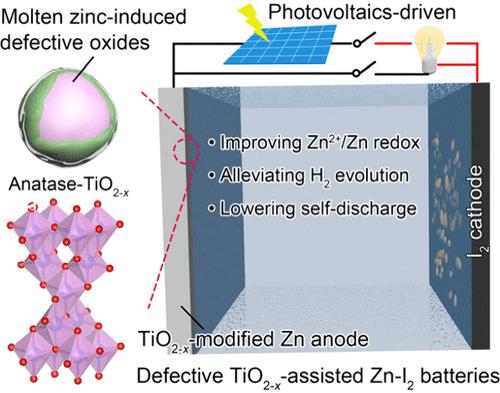熔锌调节耐用型锌-碘水电池阳极氧化还原的一般氧空位工程
IF 9.1
1区 材料科学
Q1 CHEMISTRY, MULTIDISCIPLINARY
引用次数: 0
摘要
氧空位工程在调节表面化学以管理氧化还原行为方面发挥着至关重要的作用。然而,氧空位的可控植入以及安全、高成本效益的生产仍然具有挑战性。在此,我们报告了一种通用的熔锌还原技术,该技术可在轻度升温条件下制备空位含量可调、合成通用、工业兼容的缺氧氧化物。以 TiO2 为例,理论研究表明,随着支持熔融锌供应的表面覆盖率的增加,TiO2 上的锌亲和性在热力学上是有利的。TiO2-x 纳米粒子具有良好的电子结构和较差的氢进化活性,被用来装饰水性锌阳极,其循环稳定性大大提高,这一点已通过理论、原位和非原位研究得到验证。最终,使用改性锌阳极组装了锌碘电池,由于调节了阳极氧化还原和减轻了自放电行为,电池获得了良好的循环性能。这项研究为持久的锌水电池和相关系统提供了一种深入理解的通用氧气空缺工程技术。本文章由计算机程序翻译,如有差异,请以英文原文为准。

General Oxygen Vacancy Engineering by Molten Zinc to Regulate Anode Redox for Durable Aqueous Zinc–Iodine Batteries
Oxygen vacancy engineering plays a crucial role in regulating surface chemistry for managing redox behaviors. However, controllable implantation of oxygen vacancy and safe and cost-effective production remain challenging. Herein, we report a general molten zinc reduction technology to prepare oxygen-deficient oxides with tunable vacancy content, synthetic universality, and industrial compatibility under mildly elevated temperature. Taking TiO2 as an example, theoretical study demonstrates thermodynamically favorable zinc affinity on TiO2 with increasing surface coverage supporting molten Zn supply. Featuring favorable electronic structures and inferior hydrogen evolution activity, TiO2–x nanoparticles were used to decorate aqueous Zn anodes, which demonstrate much improved cycling stability, verified by theoretical and in situ and ex situ investigations. Eventually, zinc–iodine batteries were assembled using modified Zn anodes, which achieved favorable cycling performance due to the regulated anode redox and alleviated self-discharge behaviors. This work provides a general oxygen vacancy engineering technology with an in-depth understanding for durable aqueous zinc batteries and related systems.
求助全文
通过发布文献求助,成功后即可免费获取论文全文。
去求助
来源期刊

Nano Letters
工程技术-材料科学:综合
CiteScore
16.80
自引率
2.80%
发文量
1182
审稿时长
1.4 months
期刊介绍:
Nano Letters serves as a dynamic platform for promptly disseminating original results in fundamental, applied, and emerging research across all facets of nanoscience and nanotechnology. A pivotal criterion for inclusion within Nano Letters is the convergence of at least two different areas or disciplines, ensuring a rich interdisciplinary scope. The journal is dedicated to fostering exploration in diverse areas, including:
- Experimental and theoretical findings on physical, chemical, and biological phenomena at the nanoscale
- Synthesis, characterization, and processing of organic, inorganic, polymer, and hybrid nanomaterials through physical, chemical, and biological methodologies
- Modeling and simulation of synthetic, assembly, and interaction processes
- Realization of integrated nanostructures and nano-engineered devices exhibiting advanced performance
- Applications of nanoscale materials in living and environmental systems
Nano Letters is committed to advancing and showcasing groundbreaking research that intersects various domains, fostering innovation and collaboration in the ever-evolving field of nanoscience and nanotechnology.
 求助内容:
求助内容: 应助结果提醒方式:
应助结果提醒方式:


